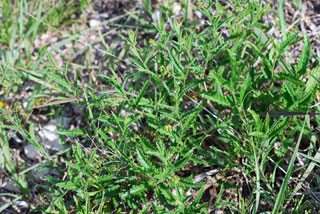CATNIP NOSEBURN
|
 |
| File Size: 159 KB |
|
|
|
Tragia ramosa Torr.
|
| Konza Prairie, Riley County, Kansas |
| Perennial |
| Height: 4-20 inches |
| Family: Euphorbiaceae - Spurge Family |
| Flowering Period: June, July, August, September |
|
| Stems: | | Decumbent to ascending or erect; sap watery. | | Leaves: | | Cauline, alternate, simple; stipules present; petiole 1/25 to 2/5 inch; blade narrowly ovate to linear-lanceolate, 1/5 to 1.6 inch long, 1/8 to 4/5 inch wide, base subcordate to truncate, margins serrate, tip acute. | | Inflorescences: | | Racemes, axillary or terminal, 1/5 to 3/5 inch; staminate and pistillate flowers on same plant, pistillate flowers proximal and staminate flowers distal; staminate flowers 2-20 per raceme, pistillate flowers 1-2 per raceme; staminate bracts lanceolate, 1/16 to 1/12 inch; pistillate bracts 1/25 to 1/16 inch. | | Flowers: | | Staminate flowers greenish: pedicels to 1/12 inch; sepals 3-4, oblanceolate, 1/25 to 1/11 inch; petals 0; stamens 3-6(-10). Pistillate flowers greenish: sepals 6, connate basally, lanceolate, 1/32 to 1/10 inch, shorter than gynoecium (collective term for the pistil(s) of a flower); petals 0; styles 3, connate proximally more than 1/2 their lengths, simple. | | Fruits: | | Capsules 3-lobed, not enveloped by persistent bracts, 1/8 to 1/6 inch long, 1/4 to 1/3 inch wide; seeds dark brown, globose to ovoid, 1/10 to 1/7 inch. | | Habitat: | | Rocky to gravelly tallgrass, mixed-grass, and shortgrass prairies | | Distribution: | | West 4/5 of Kansas | | Origin: | | Native | | Comments: | | The herbage is covered with stiff stinging hairs that are painful when touched, thus the common name nose burn.
Tragia, for Hieronymus Bock, a German botanist whose Latinized name was Tragus and ramosa, branched. | | | | See also Betony noseburn |
|
| Catnip noseburn |  | | 127 KB | | Konza Prairie, Riley County, Kansas |
| | Catnip noseburn |  | | 111 KB | | Konza Prairie, Riley County, Kansas |
| | Catnip noseburn leaf |  | | 82 KB | | Tallgrass Prairie National Preserve, Chase County, Kansas |
| | Catnip noseburn fruit |  | | 97 KB | | Tallgrass Prairie National Preserve, Chase County, Kansas |
| |
|
|
|
|
|
|